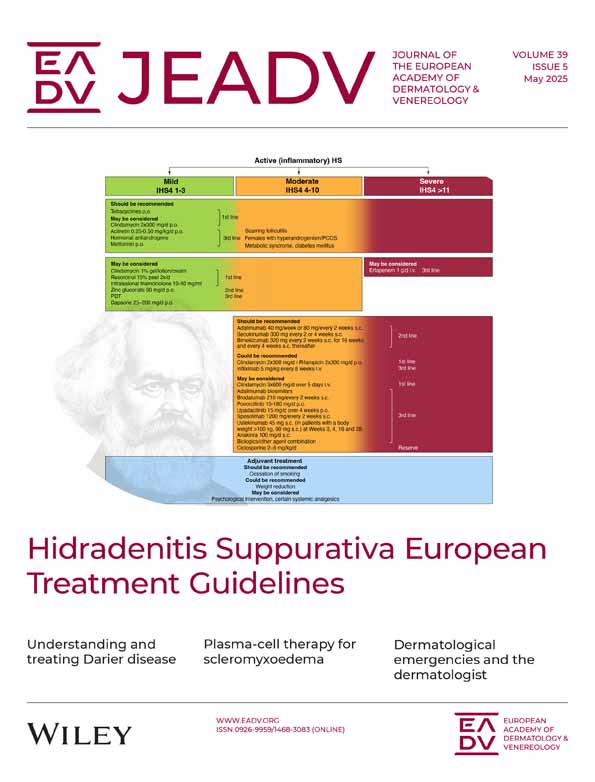Epidermolytic ichthyosis: New insights and ongoing challenges
Linked article: L. Frommherz et al. J Eur Acad Dermatol Venereol. 2025;39:1028–1037. https://doi.org/10.1111/jdv.20096.
I read with great interest the paper by Frommherz et al.1 published in this issue. The study provides a focused analysis of epidermolytic ichthyosis (EI)—a well-defined subgroup of congenital ichthyosis (CI)—which minimizes heterogeneity bias and includes a large patient cohort despite the disease's rarity.
It highlights that, similar to other forms of CI, the burden of EI is significant—particularly due to itch, pain and the high cost of skin care—and provides new insights into genotype–phenotype correlations. Moreover, this study provides us with the opportunity to discuss future research directions.
The authors demonstrated a significant impact on quality of life (QOL) in EI patients. Although the DLQI, a widely used generic dermatology tool, was used in this study, adopting a validated ichthyosis-specific measure such as IQOL-322 may more precisely capture the disease impact; however, this score remains unavailable for paediatric use.
Regarding severity assessment, although the Ichthyosis Area Severity Index (IASI) is validated and user-friendly, it does not account for other anomalies that impact disease severity. Therefore, the authors modified the IASI to include palmoplantar involvement. This logical modification underscores the need for scoring systems that capture all manifestations, but a revised score requires further validation. The authors also used the Investigator's Global Assessment (IGA 0–4), a score commonly applied in dermatology, particularly in atopic dermatitis. However, for its use in CI, a clear definition of each IGA category (clear, almost clear, mild, moderate and severe) would be necessary, along with inter-individual validation to ensure reproducibility.
Finally, their three-level classification of localized, intermediate and severe aligns with approaches in other genodermatoses but requires broader consensus and validation in EI.
This series showed that patients with KRT1 variants tended to be more severe. Future multicentre investigations pooling international cohorts could illuminate additional genetic modulators—such as the microbiome or inflammatory cytokines—that drive clinical variability.
As highlighted in the paper, there is no highly effective therapy available (gold standard: emollients and oral retinoids, as described in the updated international guidelines3). The use of biologics has recently proven disappointing. Our large international retrospective series on biologics in CI revealed that these agents may improve outcomes in only a subset of patients, with good responses observed primarily in erythrodermic forms, and not in EI.4 Future therapeutic approaches should ideally be targeted and based on the underlying functional pathways. To address this need, the Reclassifying Epidermal Differentiation Disorders Initiative task force brought together experts and patient advocates. The term ‘Epidermal Differentiation Disorder’ (EDD) was selected to cover all such inherited conditions. A revised naming system encourages genotyping and groups disorders by protein function to link them with potential treatment targets and repurposed drugs.5 EDDs were categorized into three subsets: (i) non-syndromic EDDs (nEDD), (ii) syndromic EDDs (sEDD) and (iii) EDDs predominantly affecting palmoplantar surfaces (pEDD). Disorders are named using the gene name and occasionally a functional descriptor. As an example, EI due to KRT10 variants is named KRT10-nEDD epidermolytic.
Overall, Frommherz et al. have advanced our understanding of EI's diverse presentations and heavy disease burden, emphasizing the need for validated severity scoring, dedicated QOL measures, and novel therapeutic strategies. Their work not only underscores the importance of an interdisciplinary approach to EI management but also signals that further collaborations—both clinical and research-driven—are crucial for translating emergent genotype-specific findings into effective patient care.
CONFLICT OF INTEREST STATEMENT
Investigator for the last 5 years for companies relevant to ichthyosis: Mayne, Timber Pharmaceuticals.
Open Research
DATA AVAILABILITY STATEMENT
Data sharing is not applicable to this article as no new data were created or analysed in this study.




